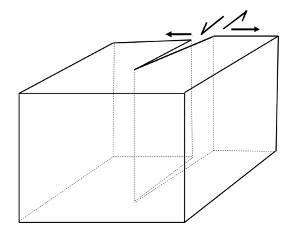| |||||||
|
|
|||||||
|
|
|||||||
| Hybrid Fractures | |||||||
|
Hybrid fractures including the major bookend components of the kinematic spectrum are proposed to occur both in nature (Engelder, 1987) and in laboratory experiments (Ramsay and Chester, 2004). An idealized diagram in Figure 1 illustrates a fracture with opening and shear components. Hybrid fractures are generally diagnosed by their orientation which is diagonal to the principal planes. The surface morphology of this type of fractures is not well-known and probably varies as a function of the contact geometry of the fracture surfaces during the development of the structure. Deformation bands with hybrid kinematics are also described in the literature. These are originally referred to as dilation or dilatant and compaction or compactive shear bands and shear enhanced compaction bands in the literature (Aydin et al., 2006; Eichhubl et al., 2010).
| |||||||
| Types of Hybrid Fractures: | |||||||
| Hybrid JointsHybrid Pressure Solution SeamsHybrid Deformation BandsHybrid Faults | |||||||
| Reference: |
|||||||
| Aydin, A., Borja, R., Eichhubl, P., 2006 Eichhubl, P., Hooker, J.N., Laubach, S.E., 2010 Engelder, T., 1987 Ramsey, J.M., Chester, F.M., 2004 |
|||||||
|
Readme | About Us | Acknowledgement | How to Cite | Terms of Use | Ⓒ Rock Fracture Knowledgebase |
|||||||
